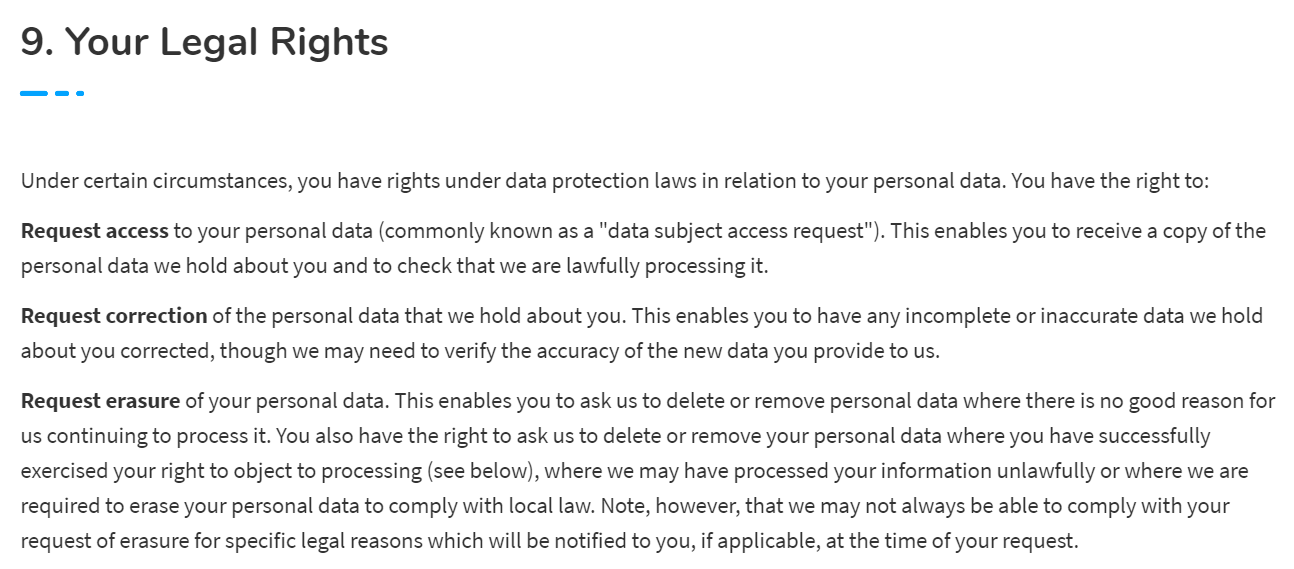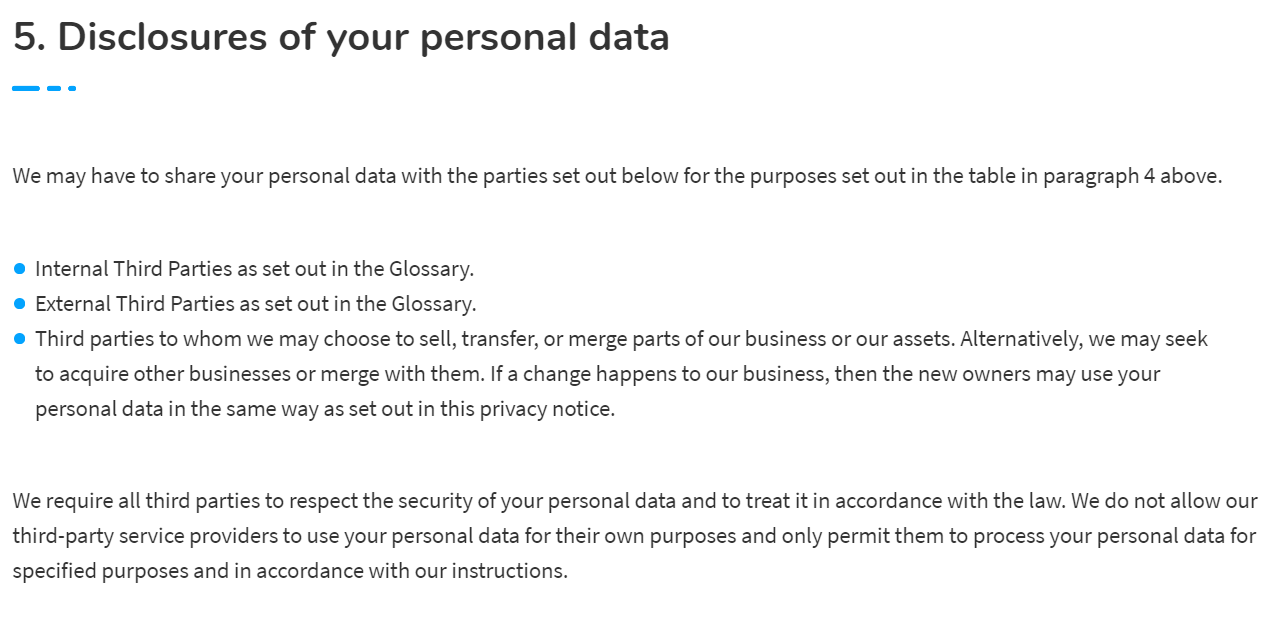How to Write a Privacy Policy (Template + Tips)
A privacy policy details the collection, storage, and usage of user data. Get a simple guide, legal tips, and a downloadable template.

Often overlooked, the privacy policy is one of the most vital parts of your website. If your site collects personal data from its users – such as form submissions or if you attach a tracking pixel – you will need a privacy policy.
Knowing how to write a privacy policy properly is critical to comply with relevant data privacy laws and data protection laws. It’s a formality required in many countries – and not having one when you should could land you in a lot of trouble. You may even have to pay a hefty fine.
So, what should a privacy policy include, and do you really, really have to write one?
Key Takeaways:
- A privacy policy is legally required if your site collects any personal data (like names, emails, or IP addresses). It protects users from legal risks and builds trust with them.
- Your policy should clearly explain what data you collect, why you collect it, how it’s used, who it’s shared with, and how it’s protected.
- Don’t start from scratch. Use a reputable generator or template (like Convertri’s built-in option) and keep your policy updated with changing laws.
Build trust with a clear, professional privacy policy page. Try Convertri free and do it right.
What is a privacy policy?
In lawful terms, a privacy policy is a web page or document that declares a company’s or a website’s privacy policy outlining its practices for collecting and disclosing visitor information. It specifies the data gathered and whether it remains confidential or is shared with or sold to other entities, such as companies, researchers, or vendors.
A privacy policy is required for you to operate within the law if you collect information from your website visitors. It’s where you let people know what personal information you’re collecting, how you collect it, how you use it, and why.
One of the most important bits of a privacy policy also describes whether you share it with any third parties – and, if you’re a decent human being, why you do this and what the user can expect from it.
Absolutely! Here’s the first section in your requested format (around 300 words, easy-to-read, engaging, with suggestions for icons, visuals, and a checklist). I’ll continue with the rest in follow-up messages to keep each section focused and high quality.
Why do you need a privacy policy?
A privacy policy isn’t just a legal formality. It’s your promise to protect users’ personal data. If your website collects any information (like names, emails, or IP addresses), a privacy policy builds trust and shows you respect your visitors’ privacy.
Without one, you risk losing credibility and even facing fines. Most customers now look for transparency. They want to know what you do with their data and who you share it with.
Plus, platforms like Google require a privacy policy for ads. If you collect emails or use tracking tools, it’s non-negotiable. A clear policy also protects you. It outlines your responsibilities related to processing personal data and can limit liability if disputes arise. Think of it as part of your digital safety net.
Quick Checklist:
- Do you collect names, emails, or user behavior data?
- Are you running ads, using analytics, or email forms?
- Do you sell or share data with third-party services?
- Do you want to avoid legal risks and build trust?
If you answered yes to any of these, you need a privacy policy—today.
Legal requirements: GDPR, CCPA & More
Different countries have different laws that require businesses to explain clearly how they handle user data. Even if you’re not based in those countries, these laws can still apply if you collect data from their residents.
| Law | Who It Affects | Key Rules | What You Must Do |
| General Data Protection Regulation (GDPR) – EU | Companies handling data of EU residents | Requires consent, data access, right to delete, breach alerts | Clear privacy policy, get consent, allow data access & deletion |
| California Consumer Privacy Act (CCPA) – USA, CA | Businesses collecting data from Californians | Right to know what data is collected, opt out of selling data | Disclose data practices, provide opt-out option |
| Health Insurance Portability and Accountability Act (HIPAA) – USA | Health-related businesses | Protects medical info, requires strict security | Keep health data confidential, disclose policies |
| Personal Information Protection and Electronic Documents Act (PIPEDA) – Canada | Canadian businesses | Consent for data collection, access, and correction | Be transparent, allow corrections |
| Lei Geral de Proteção de Dados (LGPD) – Brazil | Businesses handling Brazilian data | Similar to GDPR, it includes consent and breach notification | Update policies, get consent, notify breaches |
These laws ensure your users’ privacy rights. Non-compliance can lead to big fines, damage to reputation, and lost trust. Writing a clear privacy policy that follows these rules protects both your business and your customers.
Your privacy policy isn’t optional—and neither is page speed. Test Convertri free now.
What does a privacy policy include?
Nearly every website you find will have a privacy policy nowadays. Click on it to read a real-life example of the sections you may need to include in yours.
Of course, they may have more or less information contained within the privacy policy than you need, so here’s a quick guide to the most common sections:
Introduction
Who are you? What are you all about? Why are you writing this privacy policy? An intro section isn’t mandatory, but it does help to clear up the basic facts for users and establish the kind of clear language you should be aiming for to encourage them to read further if they’ve got this far.
When it comes to a privacy policy, you can split it into as many sections as you like for easy reading. For example, here’s the first part of Convertri’s privacy policy:

Information Collection
This is where you need to disclose the types of personal data that your site collects and how you collect it from the user. Some companies combine this information into one clause, while others separate it into two separate ones, and most websites use list formats sparingly for sections like this.
In Convertri’s privacy policy, we format it into easy-to-read bullets and paragraphs. You can see clearly the kind of customer data we collect: for example, unlike LinkedIn, we don’t need your employment history, but we do find it useful to collect details about your browser type and survey responses.

Use of Information
Once you’ve collected your visitors’ information, how and why do you use it?
This is where you can reassure your visitors how your collecting data will benefit them (and it really should, otherwise don’t do it) as well as how you use the information in your business. It’s also helpful to point out that you won’t use their data for anything illegal or shady.

Third Party Disclosure
Third parties are the worst. That’s the thinking of most of your website visitors – most people hate being tracked around the internet by cookies and whatnot, or that’s what they’ll say when you enquire. The truth is, as long as you do it well, sharing data with third parties is absolutely fine as long as it benefits the customer – and you should be upfront and comprehensive in your privacy policy when you disclose who you share their info with, and why.
In Convertri, we set out who we share your data with, but keep the actual list for later on, so it doesn’t clog up the reading flow. In our case, we need to disclose your information to joint controllers and system administrators who help run our app.
Information Protection
Reassure your users that the information you store is stored securely. You don’t have to go into the nitty gritty of how you do it – you don’t want to give hackers a roadmap – it’s important that you state clearly that you do take steps and have protocols for security and know what to do if things go wrong.
It’s a good idea to mention that your site is covered by SSL encryption, which lets them know it’s highly secure without giving away too much of your security protocols. You should probably also add a disclaimer that states that no system can ever be regarded as 100% secure, just in case the worst happens.

User Legal Rights
You must also include a section with your Privacy Policy that covers the rights of your users. This is especially relevant if your Privacy Policy needs to be compliant with GDPR.
In this section, you should explain that your visitors have the right to make amendments to their data, to delete data and to review the information on them that you hold. It’s a vital section to have to remind your users of their personal power over the information stored about them on websites.
Data Retention
How long are you going to hold and use your visitors’ personal data? You need to set out just how long they can expect to be on your system, as well as why you hold it that long.
Formatting & writing best practices
A privacy policy shouldn’t read like a legal maze. It should be clear, concise, and easy for anyone to understand. Use simple language and short sentences. Aim for a tone that’s professional. This builds trust while keeping your readers engaged.
Best Practices:
- Use clear headings and subheadings. Break your policy into sections like “What Data We Collect” or “How We Use Your Information.” This helps users find answers quickly.
- Bullet points and numbered lists make a stand out. They improve scannability and reduce clutter.
- Stick to plain language. Replace jargon like “data subjects” with “you” or “users.”
- Be direct and honest. Tell users what you’re doing with their data and why. Avoid vague phrases like “may use information in various ways.”
- Make it mobile-friendly. Most people read on mobile devices, so format for smaller screens. Use short paragraphs and enough spacing.
Common Mistakes to Avoid:
- Copy-pasting generic templates. These often miss important details specific to your business or location.
- Writing in legalese. It may sound official, but it confuses readers and turns them off.
- Hiding key information. Burying how you use data in long paragraphs looks suspicious.
- Skipping updates. Laws change. So should your policy. Always keep it current.
- Forgetting internal consistency. If one part says you collect email addresses and another doesn’t mention them at all, it creates confusion.
A well-written policy is not just a necessity. It’s a trust-builder. Get to the point, make it readable, and keep your audience in mind throughout.
Make your site compliant and conversion-ready.
Should I write one from scratch?
You can write a very basic privacy policy from this guide, but we feel like we must disclose (see what we did there?) this post isn’t meant for that. It’s a basic guide to the sections you can expect from a basic privacy policy, as well as why they need to be present.
To write your own privacy policy, there are many compliant generators on the internet which will ask you a few survey-like questions and spit out a fully formed privacy policy that’s customised for you, which you can copy and paste on your own site.
A word of warning: it’s not always easy to know how compliant these websites are, and therefore if your privacy policy will actually get across the information you need it to. Rules of the internet change from time to time (such as the recent introduction of GDPR, for example), so you would need to periodically check your privacy policy.
Alternatively, you can always pay a high-priced legal body to draft and check a privacy policy just for you, if you can afford it.
…Or, just get Convertri to do it
With Convertri, you get a fully functioning privacy policy template to use, right out of the box. You just add it like any normal page, then scan the copy for the bits you need to change, such as your website’s name, which is highlighted in red. We periodically review our privacy policy template so it’s always reliable, and getting it published is as easy as 1-2-3.
It’s simply the easiest method to put a privacy policy on your site.
Grab your free privacy policy template
Need a ready-to-use privacy policy for your blog, online store, or mobile app? Download our compliant Privacy Policy Template.
Pro tip: After editing the template, link it to your website footer so it’s easy for users to find.
FAQs about privacy policy
What is a privacy policy?
It’s a document that explains how your website or business collects, uses, stores, and protects personal data. It tells users what info you gather (like names or emails) and what you do with it.
Do I need a privacy policy for my site?
Yes. If your site collects any personal information—even cookies or emails—laws in many countries require a privacy policy. This includes blogs, online stores, and service sites.
What should I include in a privacy policy?
Cover the basics:
- What data do you collect
- Why do you collect it
- How it’s stored and protected
- Who you share it with (if any)
- How users can contact you
How do I create a privacy policy?
You can:
- Use a privacy policy generator
- Hire a legal expert
- Write your own using legal templates
- Partnering with a platform with free templates like Convertri
What is an example of privacy?
Example: A user signs up for a newsletter. Your privacy policy must say how their email is stored, who sees it, and how they can unsubscribe.
Final words
No one wants to spend hours trying to decode legal jargon or guess what the GDPR requires. But your users expect privacy protection, and regulators demand it. That’s why using a clear, well-structured privacy policy matters.
Don’t let legal compliance slow you down. With Convertri, adding a legally sound privacy policy is simple. You’ll get a ready-to-use template built right into the platform, reviewed regularly to keep you covered. Just personalize the highlighted fields and publish, and you’re good to go. Its privacy is made practical for you and your users.
Got any questions? Just leave us a comment below!







